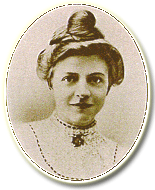History of Clara Louise Maass
If you live or work in New Jersey, you may have visited Clara Maass Medical Center, or heard of the Clara Maass School of Nursing. You may even have a recollection from elementary school of hearing of her service to humanity. If you collect stamps, you may have come across the 1976 commemorative stamp honoring Clara Maass and asked this question: Who was this woman, the first nurse honored on a United States postage stamp, as well as the first nurse for whom an American Hospital was named?
Clara Louise Maass was born on June 28, 1876 in East Orange, NJ, the first of 10 children. Her parents, Hedwig and Robert Maass, were immigrants from Germany. Robert, who was of Dutch ancestry, worked in a hat factory in Orange. In 19th century Newark and its suburbs, hat manufacturing was an important industry.
When Clara was 11 or 12, the family moved to a farm on Sycamore Avenue in Livingston. Clara attended the Northfield School, a one-room schoolhouse. The Maasses, however, were not successful at farming, and after less than two years, the family moved back to East Orange. Robert Maass worked again as a hatter; he later opened a small grocery store. To help support the family, Clara worked as a mother's helper while she finished three years of high school.
At 15, she began working at the Newark Orphan Asylum. She received $10 a month for seven days a week of work. When Clara was 17, she entered the Christina Trefz Training School of Nurses at Newark German Hospital, only the fourth such nursing school at the time in New Jersey and the first in Newark. She graduated in 1895, after two years of arduous training. In 1898, at the age of 21, she was named head nurse at Newark German Hospital.

Also that year, she served a brief engagement as a contract nurse with the United States Army during the Spanish American War. Battle wounds proved to be less deadly than diseases such as yellow fever, typhoid fever, and malaria. Clara cared for soldiers at hospitals in Jacksonville, FL; Savannah, GA; and Santiago, Cuba. She was discharged in February 1899 and returned home.
The following November, she volunteered for service in the Philippine Islands, where the US Army was fighting. After seven months in the Philippines, she became ill and was sent home.
Clara volunteered in 1900 for work in Cuba in the campaign to control yellow fever, and received a telegram from Major William C. Gorgas to report immediately for duty.
By the time Clara returned to Cuba in 1900, Major Walter Reed's work on yellow fever had established the fact that the disease was carried by mosquitoes that had bitten infected humans. Reed's work was carried on by Major Gorgas of the US Army Medical Department, working in the military government of Cuba.
Gorgas had been appointed Chief Sanitary Officer of Havana in February 1900. He was working to control yellow fever in a number of ways: improving the sanitation of the city and enforcing the use of window screens, so that mosquitoes would not spread infection; draining or pouring oil on wet areas where mosquitoes would breed; and, most importantly, setting up an inoculation experiment at Las Animas Hospital, under the direction of Dr. John Guiteras--- in the hope that a controlled infection by the bite of an infected mosquito would produce a controllable case of yellow fever, followed by immunity.



